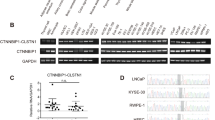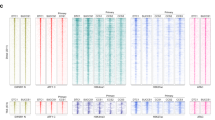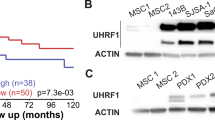Abstract
SIX1 interacts with EYA to form a bipartite transcription factor essential for mammalian development. Loss of function of this complex causes branchio-oto-renal (BOR) syndrome, whereas re-expression of SIX1 or EYA promotes metastasis. Here we describe the 2.0-Å structure of SIX1 bound to EYA2, which suggests a new DNA-binding mechanism for SIX1 and provides a rationale for the effect of BOR syndrome mutations. The structure also reveals that SIX1 uses predominantly a single helix to interact with EYA. Substitution of a single amino acid in this helix is sufficient to disrupt SIX1-EYA interaction, SIX1-mediated epithelial-mesenchymal transition and metastasis in mouse models. Given that SIX1 and EYA are overexpressed in many tumor types, our data indicate that targeting the SIX1–EYA complex may be a potent approach to inhibit tumor progression in multiple cancer types.
This is a preview of subscription content, access via your institution
Access options
Subscribe to this journal
Receive 12 print issues and online access
$189.00 per year
only $15.75 per issue
Buy this article
- Purchase on Springer Link
- Instant access to full article PDF
Prices may be subject to local taxes which are calculated during checkout





Similar content being viewed by others
References
Christensen, K.L., Patrick, A.N., McCoy, E.L. & Ford, H.L. The six family of homeobox genes in development and cancer. Adv. Cancer Res. 101, 93–126 (2008).
Kawakami, K., Sato, S., Ozaki, H. & Ikeda, K. Six family genes—structure and function as transcription factors and their roles in development. Bioessays 22, 616–626 (2000).
Rebay, I., Silver, S.J. & Tootle, T.L. New vision from Eyes absent: transcription factors as enzymes. Trends Genet. 21, 163–171 (2005).
Li, X. et al. Eya protein phosphatase activity regulates Six1-Dach-Eya transcriptional effects in mammalian organogenesis. Nature 426, 247–254 (2003).
Tootle, T.L. et al. The transcription factor Eyes absent is a protein tyrosine phosphatase. Nature 426, 299–302 (2003).
Rayapureddi, J.P. et al. Eyes absent represents a class of protein tyrosine phosphatases. Nature 426, 295–298 (2003).
Jung, S.-K. et al. Crystal structure of ED-Eya2: insight into dual roles as a protein tyrosine phosphatase and a transcription factor. FASEB J. 24, 560–569 (2010).
Abdelhak, S. et al. A human homologue of the Drosophila eyes absent gene underlies branchio-oto-renal (BOR) syndrome and identifies a novel gene family. Nat. Genet. 15, 157–164 (1997).
Ruf, R.G. et al. SIX1 mutations cause branchio-oto-renal syndrome by disruption of EYA1–SIX1-DNA complexes. Proc. Natl. Acad. Sci. USA 101, 8090–8095 (2004).
Wayne, S. et al. Mutations in the transcriptional activator EYA4 cause late-onset deafness at the DFNA10 locus. Hum. Mol. Genet. 10, 195–200 (2001).
Zhang, Y., Knosp, B.M., Maconochie, M., Friedman, R.A. & Smith, R.J.H. A comparative study of Eya1 and Eya4 protein function and its implication in branchio-oto-renal syndrome and DFNA10. J. Assoc. Res. Otolaryngol. 5, 295–304 (2004).
Schönberger, J. et al. Mutation in the transcriptional coactivator EYA4 causes dilated cardiomyopathy and sensorineural hearing loss. Nat. Genet. 37, 418–422 (2005).
Delgado-Olguín, P. et al. Epigenetic repression of cardiac progenitor gene expression by Ezh2 is required for postnatal cardiac homeostasis. Nat. Genet. 44, 343–347 (2012).
Ford, H.L., Kabingu, E.N., Bump, E.A., Mutter, G.L. & Pardee, A.B. Abrogation of the G2 cell cycle checkpoint associated with overexpression of HSIX1: a possible mechanism of breast carcinogenesis. Proc. Natl. Acad. Sci. USA 95, 12608–12613 (1998).
Yu, Y. et al. Expression profiling identifies the cytoskeletal organizer ezrin and the developmental homeoprotein Six-1 as key metastatic regulators. Nat. Med. 10, 175–181 (2004).
Micalizzi, D.S. et al. The Six1 homeoprotein induces human mammary carcinoma cells to undergo epithelial-mesenchymal transition and metastasis in mice through increasing TGF-β signaling. J. Clin. Invest. 119, 2678–2690 (2009).
Mimae, T. et al. Upregulation of Notch2 and Six1 is associated with progression of early-stage lung adenocarcinoma and a more aggressive phenotype at advanced stages. Clin. Cancer Res. 18, 945–955 (2012).
Zheng, X.-H. et al. Expression and clinical implications of homeobox gene Six1 in cervical cancer cell lines and cervical epithelial tissues. Int. J. Gynecol. Cancer 20, 1587–1592 (2010).
Ng, K.T. et al. Clinicopathological significance of homeoprotein Six1 in hepatocellular carcinoma. Br. J. Cancer 95, 1050–1055 (2006).
Ono, H. et al. SIX1 promotes epithelial-mesenchymal transition in colorectal cancer through ZEB1 activation. Oncogene 31, 4923–4934 (2012).
Behbakht, K. et al. Six1 overexpression in ovarian carcinoma causes resistance to TRAIL-mediated apoptosis and is associated with poor survival. Cancer Res. 67, 3036–3042 (2007).
McCoy, E.L. et al. Six1 expands the mouse mammary epithelial stem/progenitor cell pool and induces mammary tumors that undergo epithelial-mesenchymal transition. J. Clin. Invest. 119, 2663–2677 (2009).
Iwanaga, R. et al. Expression of Six1 in luminal breast cancers predicts poor prognosis and promotes increases in tumor initiating cells by activation of extracellular signal-regulated kinase and transforming growth factor-β signaling pathways. Breast Cancer Res. 14, R100 (2012).
Wang, C.-A. et al. SIX1 induces lymphangiogenesis and metastasis via upregulation of VEGF-C in mouse models of breast cancer. J. Clin. Invest. 122, 1895–1906 (2012).
Ng, K.T.P. et al. Suppression of tumorigenesis and metastasis of hepatocellular carcinoma by shRNA interference targeting on homeoprotein Six1. Int. J. Cancer 127, 859–872 (2010).
Darnell, J.E. Transcription factors as targets for cancer therapy. Nat. Rev. Cancer 2, 740–749 (2002).
Li, C.M. et al. Gene expression in Wilms' tumor mimics the earliest committed stage in the metanephric mesenchymal-epithelial transition. Am. J. Pathol. 160, 2181–2190 (2002).
Wang, Q.-F. et al. MLL fusion proteins preferentially regulate a subset of wild-type MLL target genes in the leukemic genome. Blood 117, 6895–6905 (2011).
Miller, S.J. et al. Inhibition of Eyes Absent Homolog 4 expression induces malignant peripheral nerve sheath tumor necrosis. Oncogene 29, 368–379 (2010).
Zhang, L. et al. Transcriptional coactivator Drosophila eyes absent homologue 2 is up-regulated in epithelial ovarian cancer and promotes tumor growth. Cancer Res. 65, 925–932 (2005).
Farabaugh, S.M., Micalizzi, D.S., Jedlicka, P., Zhao, R. & Ford, H.L. Eya2 is required to mediate the pro-metastatic functions of Six1 via the induction of TGF-β signaling, epithelial-mesenchymal transition, and cancer stem cell properties. Oncogene 31, 552–562 (2012).
Pandey, R.N. et al. The Eyes Absent phosphatase-transactivator proteins promote proliferation, transformation, migration, and invasion of tumor cells. Oncogene 29, 3715–3722 (2010).
Moon, A.F., Mueller, G.A., Zhong, X. & Pedersen, L.C. A synergistic approach to protein crystallization: combination of a fixed-arm carrier with surface entropy reduction. Protein Sci. 19, 901–913 (2010).
Holm, L. & Sander, C. Protein structure comparison by alignment of distance matrices. J. Mol. Biol. 233, 123–138 (1993).
Ades, S.E. & Sauer, R.T. Specificity of minor-groove and major-groove interactions in a homeodomain-DNA complex. Biochemistry 34, 14601–14608 (1995).
Hu, S., Mamedova, A. & Hegde, R.S. DNA-binding and regulation mechanisms of the SIX family of retinal determination proteins. Biochemistry 47, 3586–3594 (2008).
Percival-Smith, A., Müller, M., Affolter, M. & Gehring, W.J. The interaction with DNA of wild-type and mutant fushi tarazu homeodomains. EMBO J. 9, 3967–3974 (1990).
Shang, Z. et al. Design of a 'minimAl' homeodomain: the N-terminal arm modulates DNA binding affinity and stabilizes homeodomain structure. Proc. Natl. Acad. Sci. USA 91, 8373–8377 (1994).
Liu, Y. et al. Discovery, optimization and validation of an optimal DNA-binding sequence for the Six1 homeodomain transcription factor. Nucleic Acids Res. 40, 8227–8239 (2012).
Kawakami, K., Ohto, H., Ikeda, K. & Roeder, R.G. Structure, function and expression of a murine homeobox protein AREC3, a homologue of Drosophila sine oculis gene product, and implication in development. Nucleic Acids Res. 24, 303–310 (1996).
Harris, S.E., Winchester, C.L. & Johnson, K.J. Functional analysis of the homeodomain protein SIX5. Nucleic Acids Res. 28, 1871–1878 (2000).
Patrick, A.N., Schiemann, B.J., Yang, K., Zhao, R. & Ford, H.L. Biochemical and functional characterization of six SIX1 Branchio-oto-renal syndrome mutations. J. Biol. Chem. 284, 20781–20790 (2009).
Kussie, P.H. et al. Structure of the MDM2 oncoprotein bound to the p53 tumor suppressor transactivation domain. Science 274, 948–953 (1996).
Sattler, M. et al. Structure of Bcl-xL-Bak peptide complex: recognition between regulators of apoptosis. Science 275, 983–986 (1997).
Vassilev, L.T. et al. In vivo activation of the p53 pathway by small-molecule antagonists of MDM2. Science 303, 844–848 (2004).
Tse, C. et al. ABT-263: a potent and orally bioavailable Bcl-2 family inhibitor. Cancer Res. 68, 3421–3428 (2008).
Azuma, N., Hirakiyama, A., Inoue, T., Asaka, A. & Yamada, M. Mutations of a human homologue of the Drosophila eyes absent gene (EYA1) detected in patients with congenital cataracts and ocular anterior segment anomalies. Hum. Mol. Genet. 9, 363–366 (2000).
Orten, D.J. et al. Branchio-oto-renal syndrome (BOR): novel mutations in the EYA1 gene, and a review of the mutational genetics of BOR. Hum. Mutat. 29, 537–544 (2008).
Krug, P. et al. Mutation screening of the EYA1, SIX1, and SIX5 genes in a large cohort of patients harboring branchio-oto-renal syndrome calls into question the pathogenic role of SIX5 mutations. Hum. Mutat. 32, 183–190 (2011).
Bonini, N.M., Bui, Q.T., Gray-Board, G.L. & Warrick, J.M. The Drosophila eyes absent gene directs ectopic eye formation in a pathway conserved between flies and vertebrates. Development 124, 4819–4826 (1997).
Bui, Q.T., Zimmerman, J.E., Liu, H. & Bonini, N.M. Molecular analysis of Drosophila eyes absent mutants reveals features of the conserved Eya domain. Genetics 155, 709–720 (2000).
Grifone, R. et al. Eya1 and Eya2 proteins are required for hypaxial somitic myogenesis in the mouse embryo. Dev. Biol. 302, 602–616 (2007).
Worth, C.L., Preissner, R. & Blundell, T.L. SDM–a server for predicting effects of mutations on protein stability and malfunction. Nucleic Acids Res. 39, W215–W222 (2011).
Buller, C., Xu, X., Marquis, V., Schwanke, R. & Xu, P.X. Molecular effects of Eya1 domain mutations causing organ defects in BOR syndrome. Hum. Mol. Genet. 10, 2775–2781 (2001).
Mutsuddi, M. et al. Using Drosophila to decipher how mutations associated with human branchio-oto-renal syndrome and optical defects compromise the protein tyrosine phosphatase and transcriptional functions of eyes absent. Genetics 170, 687–695 (2005).
Rayapureddi, J.P. & Hegde, R.S. Branchio-oto-renal syndrome associated mutations in Eyes Absent 1 result in loss of phosphatase activity. FEBS Lett. 580, 3853–3859 (2006).
Ikeda, K., Watanabe, Y., Ohto, H. & Kawakami, K. Molecular interaction and synergistic activation of a promoter by Six, Eya, and Dach proteins mediated through CREB binding protein. Mol. Cell Biol. 22, 6759–6766 (2002).
Wrana, J.L. et al. TGF β signals through a heteromeric protein kinase receptor complex. Cell 71, 1003–1014 (1992).
Drasin, D.J., Robin, T.P. & Ford, H.L. Breast cancer epithelial-to-mesenchymal transition: examining the functional consequences of plasticity. Breast Cancer Res. 13, 226 (2011).
Minor, W., Cymborowski, M., Otwinowski, Z. & Chruszcz, M. HKL-3000: the integration of data reduction and structure solution–from diffraction images to an initial model in minutes. Acta Crystallogr. D Biol. Crystallogr. 62, 859–866 (2006).
Sheldrick, G.M. Experimental phasing with SHELXC/D/E: combining chain tracing with density modification. Acta Crystallogr. D Biol. Crystallogr. 66, 479–485 (2010).
Otwinowski, Z. Maximum likelihood refinement of heavy atom parameters. in Isomorphous Replacement and Anomalous Scattering (eds. Evans, P. & Leslie, A.) 80–85 (SERC Daresbury Laboratory, 1991).
Cowtan, K. dm': An automated procedure for phase improvement by density modification. Joint CCP4 ESF-EACBM Newsl. Protein Crystallogr. 31, 34–38 (1994).
Cohen, S.X. et al. Towards complete validated models in the next generation of ARP/wARP. Acta Crystallogr. D Biol. Crystallogr. 60, 2222–2229 (2004).
Adams, P.D. et al. The Phenix software for automated determination of macromolecular structures. Methods 55, 94–106 (2011).
Emsley, P., Lohkamp, B., Scott, W.G. & Cowtan, K. Features and development of Coot. Acta Crystallogr. D Biol. Crystallogr. 66, 486–501 (2010).
Chen, V.B. et al. MolProbity: all-atom structure validation for macromolecular crystallography. Acta Crystallogr. D Biol. Crystallogr. 66, 12–21 (2010).
Ford, H.L. et al. Cell cycle-regulated phosphorylation of the human SIX1 homeodomain protein. J. Biol. Chem. 275, 22245–22254 (2000).
Rhodes, D.R. et al. ONCOMINE: a cancer microarray database and integrated data-mining platform. Neoplasia 6, 1–6 (2004).
Acknowledgements
The authors would like to thank M. Churchill, D. Micalizzi and W. Lilyestrom for critical reading of the manuscript as well as members of the Ford and Zhao laboratories for their help and suggestions. We would like to thank the University of Colorado AMC Biomolecular X-ray Crystallography Core; the Biostatistics and Bioinformatics Shared Resource of The University of Colorado Comprehensive Cancer Center (P30CA046934) for access to databases through Oncomine; the Advanced Light Source beam line 4.2.2 at Berkeley and J. Nix for help with earlier data collection. This work was supported by grants from the US National Cancer Institute (2R01-CA095277 and R01CA157790) to H.L.F. and from the US Department of Defense Synergistic IDEA award (W81XWH-09-1-0253), Breast Cancer Research Foundation–American Association for Cancer Research, State of Colorado (2009 and 2011) and US National Institutes of Health (R03DA030559 and R03DA033174) to H.L.F. and R.Z. A.N.P. was supported by a Pediatric Hematology/Oncology Postdoctoral Fellowship (2T32082086-11A1). Data in this paper were collected at Argonne National Laboratory, Structural Biology Center at the Advanced Photon Source operated by University of Chicago Argonne, LLC, for the US Department of Energy, Office of Biological and Environmental Research, under contract DE-AC02-06CH11357.
Author information
Authors and Affiliations
Contributions
A.N.P. performed the structural and biochemical experiments. J.H.C. performed the cell culture and animal experiments. A.L.S. performed the bioinformatic analyses. R.Z. and X.S.C. designed and supervised the structural and biochemical experiments. H.L.F. designed and supervised the cell culture and animal experiments. A.N.P., R.Z. and H.L.F. designed and conceived of the overall experimental design throughout the manuscript and together wrote the manuscript. All authors participated in the preparation of the manuscript.
Corresponding authors
Ethics declarations
Competing interests
The authors declare no competing financial interests.
Supplementary information
Supplementary Text and Figures
Supplementary Figures 1–5 (PDF 3685 kb)
Data set
Supplementary Table 1 (XLSX 20 kb)
Rights and permissions
About this article
Cite this article
Patrick, A., Cabrera, J., Smith, A. et al. Structure-function analyses of the human SIX1–EYA2 complex reveal insights into metastasis and BOR syndrome. Nat Struct Mol Biol 20, 447–453 (2013). https://doi.org/10.1038/nsmb.2505
Received:
Accepted:
Published:
Issue Date:
DOI: https://doi.org/10.1038/nsmb.2505
This article is cited by
-
Retinal determination gene networks: from biological functions to therapeutic strategies
Biomarker Research (2023)
-
SIX1 amplification modulates stemness and tumorigenesis in breast cancer
Journal of Translational Medicine (2023)
-
The value of EYA1/3/4 in clear cell renal cell carcinoma: a study from multiple databases
Scientific Reports (2023)
-
A NIK–SIX signalling axis controls inflammation by targeted silencing of non-canonical NF-κB
Nature (2019)
-
Eya3 partners with PP2A to induce c-Myc stabilization and tumor progression
Nature Communications (2018)



